- Home ›
- Bamboo Plants ›
- Golden Bamboo
Golden Bamboo - Fishpole Bamboo
With the common names of Golden bamboo or Fishpole Bamboo, Phyllostachys aurea, is a popular species cultivated successfully in different countries such as UK, US, and Asia.
The name ‘Golden’ is not really the correct name to use but it has become the most commonly used. Being popular for creating walking sticks and fishing rods in Japan and China, this species more common name should really be Fish-pole Bamboo. See more about usage below.
The behaviour of this species can be varied with running quite rampantly in warmer climates but it can also be a clumping species in colder climatic conditions. It does like to have full sun in preference to any shade and will not do well if it does not receive enough of its main health requirement... sunlight.
Golden Bamboo / Phyllostachys aurea
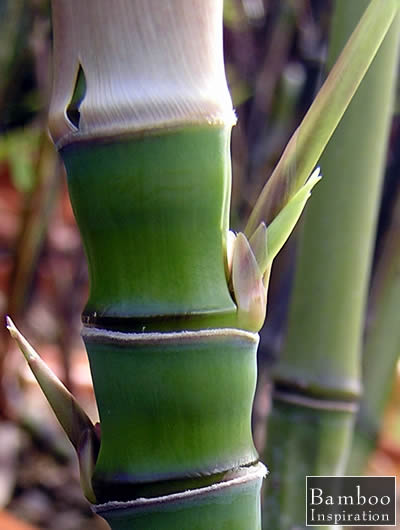
Spread and Growing Habit
Great species for a bamboo hedge, garden fence, or screen. Over about ten years Phyllostachys aurea it is likely to spread 1-3 m (3.3-10 ft.) depending on the climate and conditions and if it decides to stay as tight clumping or start running. Located in good full sun this species may become quite aggressive. Personally, unless I wanted it to spread, I wouldn’t plant it somewhere where you will be depending on it clumping unless you are prepared to maintain it, just in case it decides to run.
Height
As always, climate and location play a part in how high any bamboo plant will grow and the same applies to Phyllostachys aurea.
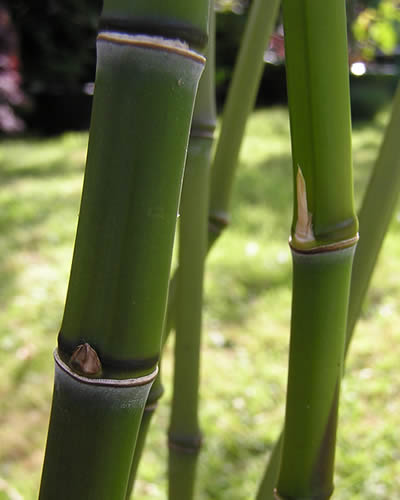
Local conditions can affect the height, health, and spread of the plant.
With the right conditions you may achieve a height of around 8 m (26 ft.) whereas if the conditions are not perfect this bamboo species may only reach a height of 4 m (13 ft.).
It is usual to get an average height of around 6 m (20 ft.) though and that makes for a good hedge or privacy screen in your garden.
I have a couple of P. aurea in pots that have already achieved a height of 4 m (13 ft.) and having just put them in larger pots the new shoots look like they will make a greater height and culm width although they are in containers.
Culm Width
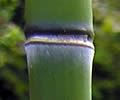
The maximum the culms of Golden Bamboo reach is a diameter of 4.5 cm (1.75 in.).
Again depending on the climatic conditions and health of the bamboo plant.
Shoots
As this species matures, a healthy plant will produce lots of new shoots every year during the growing period.
Sheath
I’ve seen some lovely colours left around the nodes and sheath scars when the sheaths have come off the culm, ranging from white to grey to a beautiful blue colour.
This has been particularly true of the culms of mature plants with the nodes close together at the base.
Culms
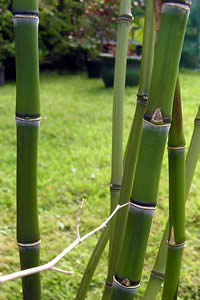
The culms are a bright and lush green but can change to a cream coloured yellow with age, poor health, or really bright sunshine.
Some new culms produce nodes that are very close together at the bottom of the culm with swelling below each node that causes it to be somewhat misshapen and woody, although they can look quite ornamental. This is exactly what makes this species so good for making fishing rods and walking sticks, the misshapen swellings of these nodes make great hand grips.
The culm internodes grooves (sulci) of Phyllostachys aurea are quite pronounced and are another characteristic of this plant.
Keeping them in containers without caring for the plants or starving them can lead to poor health and culm yellowing.
Branches
On the culms that grow with nodes close together at the bottom the new low growing branches create an interesting and almost fan like effect. When the culm has matured the lower branches can be removed to reveal the culm if required.
Leaves
The leaves are a bright green with a measurement of approximately 13 x 2 cm, (5 – 0.75 in.).
Foliage of the Golden Bamboo / Fish pole Bamboo is quite light on young bamboo plants but becomes high and denser as the plant matures.
Hardiness
Hardy to a minimum temperature of -20°C (-4°F), zone 6
Uses of Golden Bamboo
As mentioned previously, Phyllostachys aurea makes excellent bamboo hedging, screens, and windbreaks for gardens and landscapes or has impact as an individual specimen.
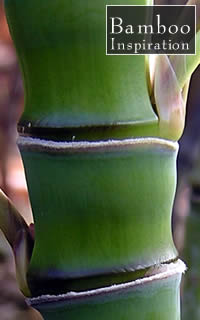
Provided it gets enough sunlight it can be planted anywhere where it has some room as it looks best where it has space to form its dense growth.
Due to its dense top heavy type of growth it is not really suitable for containers unless a shallow and very wide container is provided to give it some stability.
You will also need to feed this plant if kept in a container otherwise its health will suffer and it won’t grow to its potential or look very good.
For use as a material in crafts, due to the close node structure of some of the lower part of the culms, it has been used in the making of walking sticks and fishing rods.
The crowded cluster of nodes makes good handle grips for these products. See large photo further up the page for a closeup of the nodes.
Variety
Phyllostachys aurea ‘Flavescens Inversa’ - Pale green good culms that have golden sulci colouring,. The nodes are closely crowded together at the base on some culms; usually tightly clump forming in growing habit.